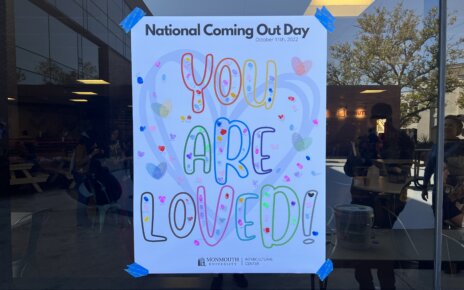Addition Will Include Student Lounge, Auditorium, Four Classrooms and Eight Offices
 Thanks to a generous donation by Steve Pozycki, CEO of SJP Properties and member of the Board of Trustees of the University, plans have been made for a 20,000 square-foot building addition onto the north side of Bey Hall in order to grant more space for the Leon Hess Business School (LHBS) and the Kislak Real Estate Institute (KREI).
Thanks to a generous donation by Steve Pozycki, CEO of SJP Properties and member of the Board of Trustees of the University, plans have been made for a 20,000 square-foot building addition onto the north side of Bey Hall in order to grant more space for the Leon Hess Business School (LHBS) and the Kislak Real Estate Institute (KREI).
Administrative Services is hoping for a groundbreaking by the end of this May with the project being completed by September 2014. After an approval hearing in front of West Long Branch on March 28, the University can determine when construction may begin.
The addition will be built between Bey Hall and the Rebecca Stafford Student Center (RSSC). The two-story building will be linked to Bey Hall and will consist of four general-purpose classrooms that will seat 30 students, a 170-seat auditorium, eight faculty offices, and a student lounge. According to the preliminary plans, which have not been finalized, the open floor plan will appear similar to Bey Hall, with some of the differences being that the common area on the second floor will be 1300 square feet wider and the building will include an outdoor patio.
The addition will not enter the commuter parking lot. Patti Swannack, Vice President of Administrative Services, said, “We want to preserve as much green space as possible. I think that this space will lend itself really well to students congregating inside and outside onto the patio.” Swannack also mentioned that since the green space is very wet right now, the drainage will need to be improved before construction begins.
Much of the construction will come onto the black pavement sidewalks, which will also be refined as a part of the process. The trees that would be displaced will be relocated and more trees will be planted as well.
Swannack said, “We are the largest green space in West Long Branch and we really want to retain this; including spaces such as the Great Lawn or the green space in front of the Guggenheim Library.”
She also said that the University has been looking at ways to improve Bey Hall for about two years to increase the amount of space allotted to the LHBS and the KREI. Young Auditorium in Bey Hall seats 120 people and the Wilson Auditorium seats 250, so the 170-person auditorium in Pozycki Hall will be a middle ground.
 Peter Reinhart, Director of the KREI, said, “Pozycki Hall will provide new, larger and more technologically advanced classrooms as well as a larger auditorium to continue and expand not only the real estate program, but the entire business program within the LHBS. I hope that with the new Pozycki Hall and the growing number of KREI alums now in the industry making their mark that the reputation and influence of the University will continue to grow.”
Peter Reinhart, Director of the KREI, said, “Pozycki Hall will provide new, larger and more technologically advanced classrooms as well as a larger auditorium to continue and expand not only the real estate program, but the entire business program within the LHBS. I hope that with the new Pozycki Hall and the growing number of KREI alums now in the industry making their mark that the reputation and influence of the University will continue to grow.”
Also, Swannack said that the original classrooms designed in Bey Hall have become too small for the number of students they must seat so this is a way to create more classroom space.
Donald Moliver, Dean of the LHBS, said, “We need space to provide an enhanced learning environment. We are not doing this to attract more students; rather, we want them to be more comfortable in the space we do provide as some of the classrooms on the second floor of Bey Hall in particular are poorly configured and uncomfortable.”
Marissa Cusanelli, junior business administration major, agrees with Moliver. She said that the space in Bey Hall is good, but she thinks that students could benefit from larger classrooms.
“I would personally prefer more boardroom-styled seating classes instead of the traditional classroom atmosphere with desks. The finance lab was a great addition to Bey Hall this past year, and I feel that more things like that would greatly benefit not only the business school students but everyone at the University as a whole,” Cusanelli said.
Swannack said, “We can only accommodate so many students. We are restrained by size. And we think that the size of the University that it’s at is good. Our mantra has been to improve the quality of our facilities, not increase the student population.”
The University will be paying for site work, landscaping, and drainage, which might be $1,000,000 when completed. Each year, the University budgets an amount of money for capital spending and improvements, so a portion of that will go to this project for this year.
Micah Freedman, junior business administration major, said, “Where I have negative views is the price the students must pay in tuition to sponsor these projects. My tuition has gone up close to $10,000 while attending MU. If the school does construction that is paid for largely by the students’ tuition, then it best be an integral part of our campus.”
Even though the University will be paying construction costs, the building itself is completely donated by Pozycki.
Reinhart said, “Steve Pozycki has been a wonderful benefactor for Monmouth and particularly the KREI. As a major leader in the New Jersey and New York real estate industry, he never forgot his roots as a Monmouth alumnus. Beginning with his generous endowment of the Pozycki chair in real estate and now to Pozycki Hall, he has helped so many of our students learn and now begin their careers in real estate.”
Swannack said that she has briefly spoken about the project to the Student Government Association (SGA) who had no concerns and were very supportive. Moliver also said that he does not think students will be inconvenienced at all and he hopes the excavation will occur in the summer, yet students will find it exciting no matter what to follow the progress of the addition.
Reinhart said, “Obviously, there will be some temporary, minor inconveniences as with any construction project, but once completed, it will be a major permanent improvement to Bey Hall, which is now over 20 years old.”
Brooke McCarthy, junior accounting major, said that the construction does not bother her because she knows it is to benefit the students. “It always feels like a bit of a jab hearing about future projects that I most likely won’t get to utilize even though I’m paying for it, but that’s how it has always worked, so I can’t complain too much,” she said.
Administrative Services tries to do renovations and maintenance every year, said Swannack. In the future, the University is planning for renovations and additions such as a four-lane bowling alley, renovations of Thomas A. Edison Hall, RSSC serving area, replacement of the flooring and paint in the RSSC dining area, a new residence hall, painting of Redwood Hall, and renovations of the newly acquired University Bluffs.
She said, “For successful universities, this [maintenance and renovations] is standard. We are very lucky with our budget process and our board has been very supportive of these programs. Our goal is to be competitive and make MU the best experience possible and you need appropriate facilities for this to happen.”
PHOTO COURTESY of Patti Swannack


